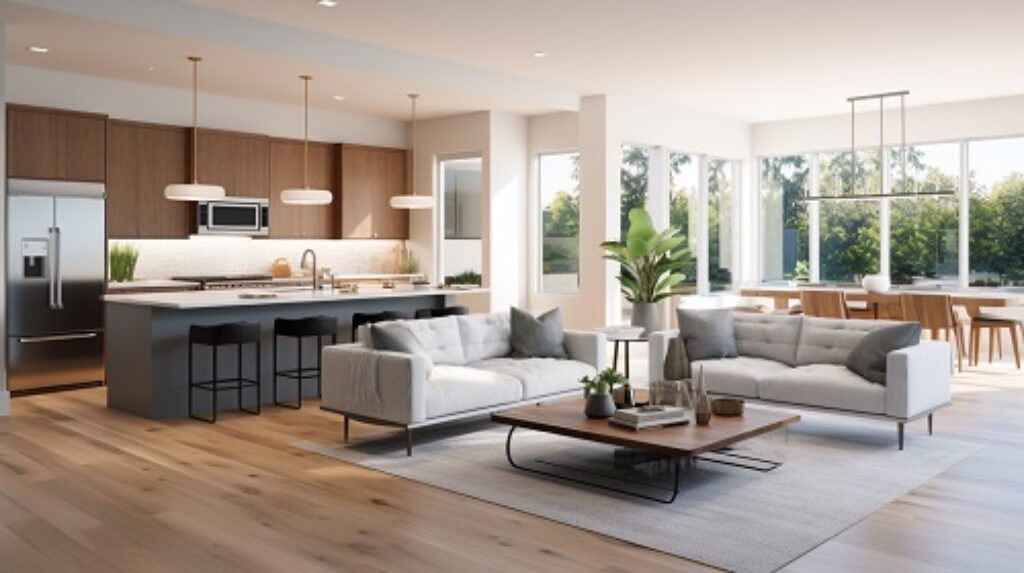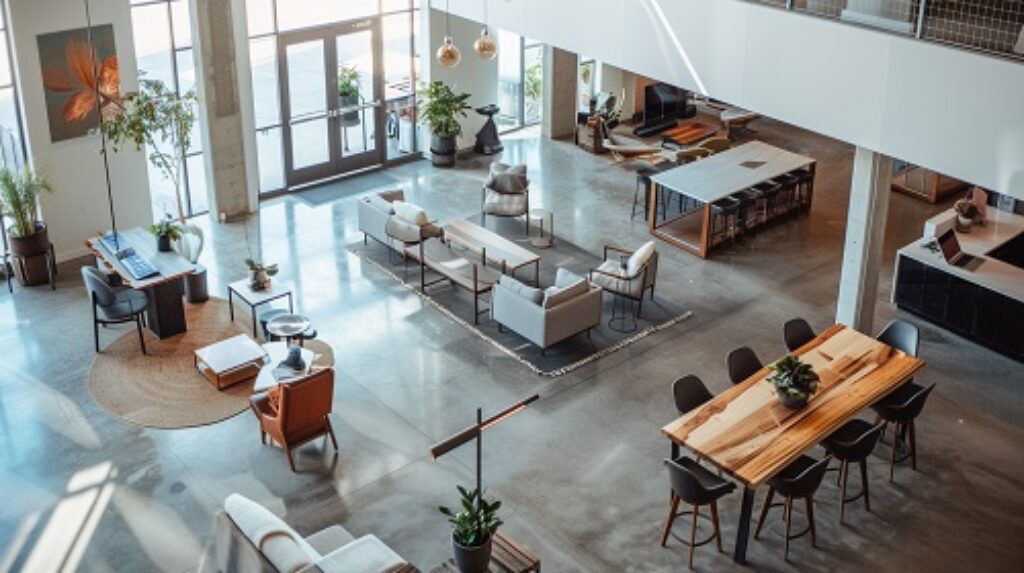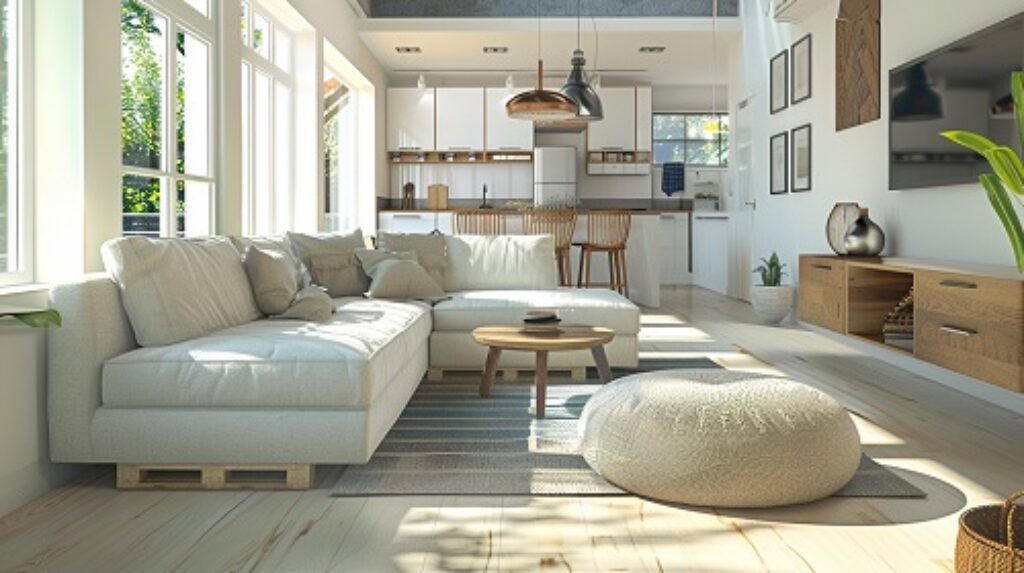Open floor plans have become very popular in modern home design. It offers a seamless flow between different areas, creating an open-concept home that feels spacious and inviting.
Whether you’re renovating your current space or building a new home, mastering open floor plan design can completely transform the look and feel of your living space.
With open floor plans, you have the freedom to create a modern layout that suits your lifestyle. It allows for more natural light, enhances connectivity between rooms, and provides ample space for gathering and entertaining. The possibilities for designing a functional and aesthetically pleasing open floor plan are endless
Key Takeaways:
- Open floor plans create a seamless flow and spacious interior design.
- Proper organization and storage are crucial in an open floor plan.
- An open floor plan offers flexibility for various activities and functions.
- Consider adding an island in the kitchen for additional workspace and multi-functionality.
- Privacy considerations and strategic furniture placement are important in open floor plan design.

Benefits of an Open Floor Plans
An open floor plan offers numerous benefits that can transform the way you experience your home. With its emphasis on flow and connectivity, an open floor plan creates a seamless transition between different areas, allowing for easy interaction and communication. Integrated living areas are a hallmark of this design, providing a sense of openness and spaciousness that can make your home feel larger and more inviting.
One of the key advantages of an open floor plan is the flexibility it offers in terms of gathering and entertaining spaces. Whether you’re hosting a dinner party or spending time with family, the open layout allows for versatile arrangements that can accommodate various activities. From a functional perspective, an open floor plan ensures a well-designed layout that maximizes the use of space and promotes efficient movement throughout the home.
“The very nature of an open floor plan allows for more conversation, communication, and all around togetherness.” – Caitlin Kah”
When designing an open floor plan, it’s important to consider how flow and connectivity can enhance your daily life. By prioritizing the integration of living areas and creating spaces that facilitate gathering and entertaining, you can optimize the functionality of your home. Whether you’re relaxing with loved ones or hosting guests, an open floor plan provides the ideal environment for creating cherished memories in a space that truly feels like home
Table: Benefits of an Open Floor Plans
| Benefits | Description |
| Flow and Connectivity | An open floor plan creates a seamless transition between different areas, allowing for easy interaction and communication. |
| Integrated Living Areas | The open layout provides a sense of openness and spaciousness, making the home feel larger and more inviting. |
| Gathering and Entertaining Spaces | The flexible arrangement of an open floor plan accommodates various activities and provides versatile spaces for hosting gatherings and entertaining. |
| Functional Floor Plan | An open floor plan ensures a well-designed layout that maximizes the use of space and promotes efficient movement throughout the home. |
With its emphasis on flow, connectivity, and functional design, an open floor plan can truly transform your living space. By embracing this modern approach to home design, you’ll create an environment that is not only visually appealing but also optimized for the way you live and interact with others. Explore the possibilities of an open floor plan and unlock the potential of your home.
Design Considerations for Open Floor Plans
In designing an open floor plan, several considerations need to be taken into account to ensure a cohesive and visually appealing layout. Proper angles, cabinetry, furniture placement, and color coordination play pivotal roles in achieving a harmonious design.
Proper Angles
When working with an open floor plan, it is essential to consider the angles at which different areas intersect. Angles that align well with the flow of movement create a seamless transition between spaces and enhance the overall functionality of the layout. By carefully choosing the placement of walls, columns, and other structural elements, you can achieve a visually pleasing and well-integrated open floor plan.
Cabinetry and Furniture Placement
Cabinetry and furniture placement are crucial elements in differentiating separate spaces within an open floor plan while maintaining visual connectivity. Strategic placement of cabinets and furniture can create distinct zones for various activities, such as the kitchen, dining, and living areas. By carefully selecting the size, style, and placement of these elements, you can effectively define each space while ensuring a cohesive and unified design.
Color Coordination
Color coordination is key to creating a cohesive and visually appealing open floor plan. By choosing a consistent color palette that flows seamlessly throughout the space, you can establish a sense of harmony and unity. Consider using complementary colors or shades from the same color family to create a visually pleasing transition between different areas. Additionally, coordinating the colors of furniture, accessories, and other design elements with the overall Color scheme helps tie the space together and creates a cohesive aesthetic.
By taking these design considerations into account, you can create an open floor plan that not only maximizes space and promotes flexibility but also showcases a visually stunning and well-thought-out design.

Incorporating Islands in Open Floor Plans
When it comes to designing an open floor plan, incorporating kitchen islands can be a game-changer. Not only do they add visual appeal, but they also offer a myriad of functional benefits. A kitchen island provides ample walking space, allowing for easy navigation and movement within the open layout. Whether you’re carrying heavy dishes or mingling with guests, the island creates a convenient pathway, ensuring a seamless flow in your home.
But the benefits of a kitchen island in an open floor plan extend beyond just functionality. Islands serve as a multifunctional space, perfect for entertaining and socializing. Imagine hosting a dinner party with friends or family, where you can interact with guests while preparing a delicious meal. The island becomes a central hub, allowing you to engage with others while still being a part of the gathering. It creates a sense of togetherness and connectivity, making your open floor plan a hub for socializing.
Another advantage of incorporating a kitchen island in your open floor plan is the ability to repurpose it for other activities. Beyond cooking and entertaining, the island can be transformed into a versatile space that suits your lifestyle. It can serve as a homework station for your kids or a workspace for you to tackle your projects. By repurposing the island, you maximize its functionality, making it an indispensable feature in your open floor plan
Designing your Kitchen Island
When designing your kitchen island for an open floor plan, there are a few considerations to keep in mind. First, ensure that its size and placement align with the overall layout of the space. The island should not obstruct the flow of traffic but rather enhance it. Striking a balance between ample walking space and the island’s functionality is paramount.
In terms of aesthetics, choose materials and finishes that complement the rest of your open floor plan. The island can serve as a focal point, so make sure its design resonates with the overall style of your home. Consider using contrasting colors or textures to create visual interest and make the island stand out.
Ultimately, incorporating an island in your open floor plan not only adds practicality but also enhances the visual appeal of your space. It creates a seamless flow, offers a multifunctional area for socializing, and allows for repurposing based on your needs. So, when designing your open floor plan, don’t forget to include a well-designed kitchen island that truly elevates the functionality and aesthetics of your home.
Balancing Privacy in Open Floor Plans
When designing open floor plans, it’s essential to consider privacy considerations to create a harmonious and functional living space. While the open concept offers many advantages, such as a seamless flow and integrated living areas, it also presents challenges when it comes to privacy. Here are some key factors to keep in mind:
Formal Dining Area
Creating a formal dining area within open floor plans can be a bit tricky, especially when the kitchen is visible. To address this, thoughtful design solutions are necessary. You can use furniture placement and strategic lighting to visually separate the dining area from the kitchen, creating a more private and intimate space for dining.
Clutter Management
In an open floor plan, work surfaces and clutter are always on display. This makes proper organization and clutter management crucial. Consider incorporating hidden storage solutions, such as built-in cabinetry or large storage units, to keep your space clean and organized. By having designated storage areas, you can easily maintain a clutter-free environment and preserve the visual appeal of your open floor plan.
Additional Storage
Having sufficient storage space is essential in an open floor plan. With everything on display, you’ll want to make sure there are enough storage options to keep your belongings neatly tucked away. Consider incorporating additional storage solutions, such as floating shelves, built-in cabinets, or multifunctional furniture with hidden compartments. These storage options not only provide practicality but also add to the overall aesthetic of your open floor plan.
Creating a balance between openness and privacy in an open floor plan requires thoughtful design choices. By incorporating a formal dining area, managing clutter effectively, and adding extra storage options, you can enjoy the benefits of an open concept while maintaining a sense of privacy and functionality in your home.

| Privacy Consideration | Solution |
| Formal Dining Area | Create a visually separate dining area using furniture placement and strategic lighting. |
| Clutter Management | Incorporate hidden storage solutions, such as built-in cabinetry or storage units. |
| Additional Storage | Add floating shelves, built-in cabinets, or multifunctional furniture for extra storage space. |
Open Floor Plans: Trends and Tips
The popularity of open floor plans can be traced back to mid-century architecture, which embraced the concept of open-concept living. Today, open floor plans continue to be sought after for their functionality and ability to create a sense of spaciousness in a home. To make the most of an open floor plan, consider incorporating practical spaces that enhance the overall functionality of the home.
Practical spaces such as laundry rooms and mudrooms are essential considerations in open floor plan design. These areas not only provide much-needed functionality but also help to keep the main living spaces clean and clutter-free. By designating specific areas for tasks like laundry and storage, you can maintain the flow and organization of your open floor plan.
Another emerging trend in open floor plans is the broken-plan concept. This design approach combines open-plan living with partitioning to create more private areas within the open space. With the broken-plan concept, you can strike a balance between openness and privacy by strategically incorporating elements like room dividers or partial walls. These subtle separations can create distinct zones while still maintaining the overall open feel of the space.
Practical Space Ideas for Open Floor Plans
- Create a designated laundry room with ample storage for supplies and a folding area.
- Incorporate a mudroom near the entryway to keep shoes, coats, and bags organized.
- Consider a built-in desk or study nook for a dedicated workspace.
- Add a playroom or child-friendly area with storage for toys and games.
- Include a pantry or additional storage space in or near the kitchen.
The Broken-Plan Concept in Action
“The broken-plan design allows for separate areas within an open floor plan, creating a sense of intimacy and privacy while still maintaining an overall open feel.”
Interior Design Magazine
| Open Floor Plan Trends | Benefits |
| Mid-century architecture | Embraced open-concept living, creating a sense of spaciousness. |
| Practical spaces | Laundry rooms, mudrooms, and other designated areas enhance functionality. |
| Broken-plan concept | Combines open-plan living with partitioning for more private areas. |
Common Mistakes in Floor Planning
When it comes to floor planning, several common mistakes can impact both the functionality and aesthetics of a space. Avoiding these mistakes is crucial in creating a floor plan that not only maximizes space utilization but also ensures a seamless flow between rooms. Let’s take a closer look at some of these mistakes and how to avoid them:
Furniture Scale
One of the most common mistakes in floor planning is not properly considering the scale of furniture with the room size. Oversized furniture can make a room feel cramped and cluttered, while undersized furniture can make the space appear empty and disjointed. It’s important to carefully measure the dimensions of your room and select furniture that is proportionate to the space to create a harmonious balance.
Privacy Considerations
In an open floor plan, privacy can be a concern. It’s important to consider how to create defined spaces without sacrificing the open concept. One effective solution is to use architectural elements, such as partial walls or room dividers, to visually separate different areas. Additionally, thoughtful placement of furniture and strategic use of curtains or blinds can provide a sense of privacy when needed.
Storage
Insufficient storage is another common mistake in floor planning. Without proper storage solutions, clutter can quickly accumulate, detracting from the overall design of the space. Incorporating built-in cabinets, shelves, and multifunctional furniture can help maximize storage and keep the space organized and clutter-free.
Table:
| Mistake | Solution |
| Poor space utilization | Consider the function of each area and ensure the layout optimizes the available space. |
| Lack of flow between rooms | Design clear pathways that allow for easy movement between different areas. |
| Overlooking integration with existing architecture | Take into account the architectural style of the space, and make design choices that complement and enhance the existing features. |
By avoiding these common mistakes and carefully considering factors such as furniture scale, privacy considerations, storage solutions, and integration with existing architecture, you can create a well-designed floor plan that not only utilizes space effectively but also provides a functional and aesthetically pleasing living environment.

Conclusion
Creating an optimal floor plan is crucial for achieving a practical and aesthetically appealing space. A well-designed floor plan ensures a smooth flow and functionality throughout the home, enhancing the overall living experience.
By considering factors such as space utilization, flow, privacy, storage, and integration with existing architecture, we can create a floor plan that meets our needs and enhances our daily lives.
Remember, an optimal floor plan allows for efficient movement between different areas, promoting flexibility and adaptability. It creates a seamless connection between rooms and facilitates a harmonious interaction within the space.
So, whether you’re designing a new home or renovating an existing one, prioritize the creation of an optimal floor plan. It’s a fundamental step in achieving a space that not only looks great but also functions exceptionally well, enhancing your overall quality of life.
FAQ
What is an open floor plan?
An open floor plan is a layout design that eliminates walls and partitions to create a seamless flow between different areas of a home, allowing for easy interaction and communication.
What are the benefits of open floor plans?
An open floor plan offers a seamless flow and connectivity between different areas, creates a sense of openness and spaciousness, provides versatile gathering and entertaining spaces, and maximizes the use of space.
How do you design open floor plans?
To design an open floor plan, consider proper angles and layout, strategic placement of cabinetry and furniture, coordination of colors and materials, and the use of visual dividers and area rugs to differentiate spaces within the open layout.
What are the advantages of adding kitchen islands to an open floor plan?
Kitchen islands in an open floor plan enhance the layout by creating ample walking space, providing a space for preparing and serving food, and offering a versatile area for entertaining and socializing while cooking.
How can privacy be balanced in an open floor plan?
Balancing privacy in an open floor plan can be achieved through proper clutter management, creating a formal dining area, and ensuring sufficient storage space to keep things clean and neat.
What are some trends in open floor plan design?
Open floor plans have been popular for decades, with mid-century architecture embracing open-concept living. The rise of the broken-plan concept combines open-plan living with partitioning to create more private areas.
What are common mistakes in floor planning?
Common mistakes include not effectively utilizing space, poor flow between rooms, furniture not being to scale, lack of privacy considerations, insufficient storage, overlooking integration with existing architecture, and not considering clients’ needs.
How important is creating an optimal floor plan?
Creating an optimal floor plan is crucial for a functional and aesthetically appealing space. It promotes efficient flow and connectivity, enhances the overall functionality of the home, and improves usability and enjoyment.
Discover more about Home Decor Ideas


